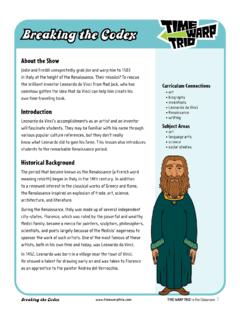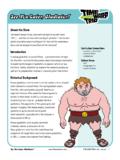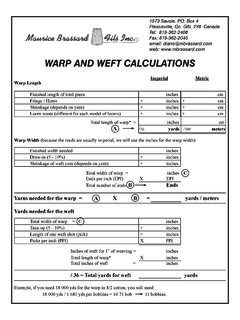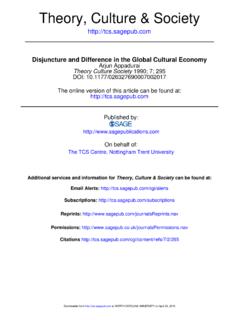Transcription of Viking It and Liking It - The Time Warp Trio
1 Time Warp Trio In the Classroom Viking It and Liking ItViking It and Liking the ShowThe boys want to play Vikings Football Smashfest, but instead find themselves in 1000 with a bunch of real Vikings! It s one wild ride with Leif Ericsson as they sail on his voyage of discovery to North many intermediate classrooms, studying explorers is a required part of the social studies curriculum. Often the role of Vikings in the history of western exploration is minimized and/or stereotyped. This lesson allows students to delve deeper into the culture and the explorations of Vikings. [Note: you can also use the activities while studying any explorers, from Eric the Red to Robert LaSalle to today s astronauts. In addition, the activity formats (commercial, Jeopardy game) can be used in many subject areas to review and present information.]Historical BackgroundVikings (from the Old Norse vikingr, a pirate or raider) sailed from Denmark, Norway, Sweden, and parts of Finland to colonize, trade, or raid.
2 During the Viking Age (800 1050), their longships traveled throughout the known world. Vikings sailed the uncharted waters of the North Atlantic, and discovered America 500 years before expansion was made possible by the Vikings superiority in shipbuilding and navigation skills. They traveled further, faster, and more confidently than their contemporaries. Their longship, a narrow and flexible boat with symmetrical ends and a true keel, was capable of high speed, both under sail and when rowed. Curriculum Connections ancient histor y explorers Vikings world histor ySubject Areas language ar ts media studies social studiesTime Warp Trio In the Classroom Viking It and Liking ItViking It and Liking Background continued Vikings were known as fierce warriors who stole and extorted gold, silver, and other valuables. However, Vikings were not exclusively raiders.
3 They developed successful commercial centers from York, England, to Kiev, Russia. In the 9th century they colonized Iceland and Greenland and established settlements in many of the lands they Vikings were also superb artists. They absorbed motifs and artistic styles from outside their homelands as quickly as they absorbed the riches of those they out the Viking adventure for kids at Wordsplosion and other interactive games to play. Plentifax 487 the ultimate time traveler s guide gives facts about the way Vikings lived, plundered, and more! Cool Books that kids will love. Want students to get even more excited about history? Time Warp Trio In the Classroom Viking It and Liking ItActivityLiving Commercialsas students create a commercial for some aspect of Viking life, they learn not only about the life and times of Vikings, but also about the techniques used by commercials to sell a.
4 As a class, brainstorm a list of favorite television, radio, or magazine ads. You may want to show clips of television commercials. Have students identify what makes them memorable. For example, students might recall soft drink commercials that use repetition, or they might remember a commercial for curing headaches in which an authority figure a person in a white lab coat urges viewers to use the product.. Ask students, How do commercials and ads get you to buy things? Write students responses on the board. Distribute the Techniques of Persuasion handout. Compare and contrast the techniques on the handout with students ideas.. Have students bring in magazine or newspaper ads that illustrate the various techniques of persuasion. Share and Have each student create a one-minute radio or television commercial that promotes some aspect of Viking life and/or exploration.
5 For example, a student might extol the virtues of the Viking longship. Or, a student might use the bandwagon technique to make a point about the usefulness of the Viking shield. Using statistics, a student could promote Vikings by describing the many destinations the Vikings reached on the European continent. 5. Students may recruit other students to be in their commercial. Be sure to provide rehearsal Hold an advertising agency board meeting in which students present their commercials to the rest of the class. If possible, videotape the presentations and watch them together. Discuss the techniques that students used in their It FurtherHave students create a one-minute commercial selling any student- selected book, using at least one of the techniques of persuasion. Make sure students include the title, author, and a brief retelling of the book. Videotape the commercials and play them in class, or invite the librarian to show them in the library.
6 The commercials may inspire students to read the recommended to identify and describe cultural ar tifacts used by Vikings or other explorers to synthesize techniques of persuasion to become more media literateMaterials ar t supplies (poster paper, markers, paint) Techniques of Persuasion handout video clips of television commercials (optional) props/costumes (optional)Curriculum Standards NCSS Time, Continuity, and Change: Students identify and use various sources for reconstructing the past, such as documents, let ters, diaries, maps, textbooks, photos, and others. NCT e/ira Students read a wide range of print and non-print texts to build an understanding of texts, of themselves, and of cultures of the United States and the world; to acquire new information; to respond to the needs and demands of societ y and the workplace; and for personal fulfillment.
7 Techniques of Persuasionin AdvertisingAssociation the implication that if one uses this product or service, one will be wealthy, beautiful, successful, thin, and happy, just like the people in the someone (celebrity, doctor, expert) uses or advises one to use the the implication or statement that everyone uses this particular product or Person a celebrity states he/she uses the Folks ordinary people are shown using the product or service and having a better the same phrase, word, color, or rhythm used over and over (at least seven times).Statistics numbers, graphs, and charts are used to imply or show why this product or service is more desirable than : Marj Montgomery and Tarry It and Liking ItTime Warp Trio In the Classroom 2005 WGBH Educational Foundation. Warp Trio In the Classroom 5 Viking It and Liking to recall significant facts about Vikings or other explorers to follow instructions while constructing a game boardMaterials two pieces of 12 x 18 construction paper per student scissors, markers, glue or paste Game Board Instructions handoutCurriculum Standards NCSSC ulture: Students explain and give examples of how language, literature, the arts, architecture, other artifacts, traditions, beliefs, values, and behaviors contribute to the development and transmission of culture.
8 NCT e/iraStudents conduct research on issues and interests by generating ideas and questions, and by posing problems. They gather, evaluate, and synthesize data from a variety of sources to communicate their discoveries in ways that suit their purpose and Jeopardyas your study of Vikings and/or other explorers draws to a close, use the Viking Jeopardy game as a way to review significant historical facts. Instructions . Review the rules of Jeopardy with students. Organize the class into groups of three or four students. Explain that groups will use a list of questions to create a Viking Jeopardy game board.. Instruct the groups to think of important questions about Vikings and/or other explorers. Have one person in the group write down the questions. Be sure that the group keeps a list of answers. (If they don t know an answer, allow them time to research it.)
9 Call on one group to share a question from their list. If any other group has that question, they must cross it out. Have the second group share a question. Other groups having that question must cross it out. Keep going until groups have shared all their questions. 4. Distribute the Game Board Instructions handout. Have each group create a game board using their questions and answers. 5. Have student groups play each other s game. Remind students that the contestants must look at the answer on the outside of the door and then try to guess the question inside the door. Be prepared to hear the Jeopardy theme song!(Note: this activity assumes knowledge of the Jeopardy game format. If you or your students are not familiar with the game, you may want to watch several episodes of the television game show. You may also want to search the Web for sites that explain how to use the Jeopardy game in the classroom, such as and )1.
10 Using a pencil, lightly label one piece of construction paper A and the other Cut six doors in piece B. These may be any shape and any size, as long there is enough room to write a question inside the door. Be sure to leave one edge of each door attached to the Open each door and fold the flap Place piece B on top of piece A. Lightly outline each of the doors on to piece Remove piece Using the six questions you have created, write one question on each door outlined on piece A. Lightly glue piece B on top of piece A, making sure that the questions are visible when the doors are open. 7. Write the answer to each question on the front of the corresponding door. You have now created a Viking Jeopardy game board! If you finish early, you can add detail (such as a border depicting Viking artifacts) to piece B, making it more attractive and/or informational.







